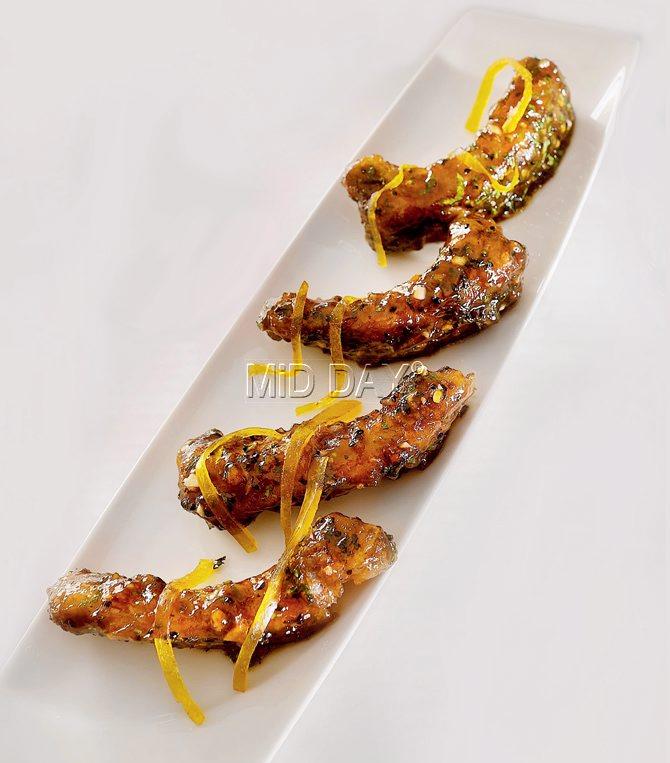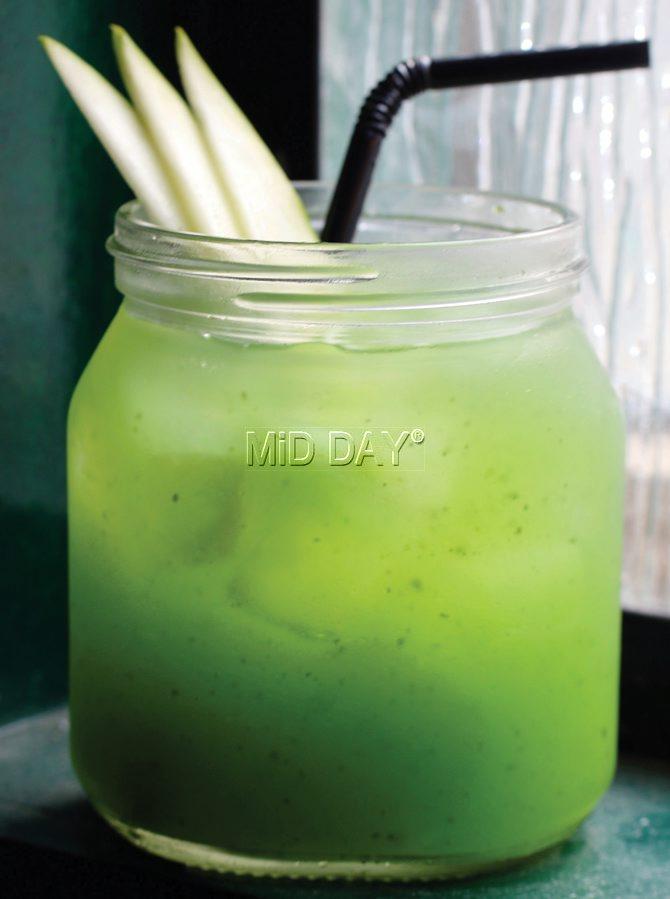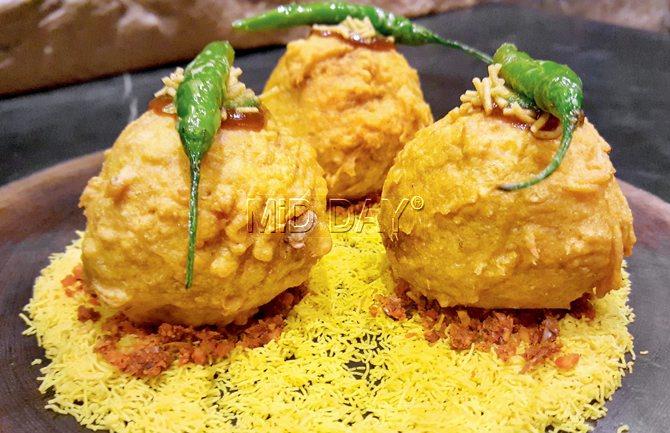A little sweet, a little sour is a marriage made in tastebud heaven. Here’s why khatta-meetha manages to woo us, on the streets and in fine-dining

A contemporary Indian take on the sweet-and-sour BBQ, chef Manish Mehrotra���¢��������s meetha achaar Canadian spare ribs come with a sun-dried mango glaze and toasted kalonji (fennel) seeds
ADVERTISEMENT
The ubiquitous aloo tikki chaat, believes Delhi-based chef Manish Mehrotra, is one of the most balanced dishes in pan-Indian cuisine. It is an unexpected, if not a puzzling, description of this commoner among Indian street snack options. "It’s a potato tikki fried on a tava, with silky yogurt and grainy masala. It’s khatta, meetha, and a shade bitter around the charred corners of the tikki — it’s a complete dish," waxes Mehrotra.

A contemporary Indian take on the sweet-and-sour BBQ, chef Manish Mehrotra’s meetha achaar Canadian spare ribs come with a sun-dried mango glaze and toasted kalonji fennel seeds. Pic/Amit Pasricha
Khatta-meetha has been teasing taste-buds since humankind has been foraging and hunting. And now, a flavour profile, once identified with street food, and supplements, such as chutneys and pickles, has found centrestage main-course presence and a lip-smacking audience in fine and casual dining set-ups. This, not just on home turf, but internationally as well.

A spin-off on the aam panna, chef Manu Chandra’s Mangaa, which has green mango puree and cumin for the balance of khatta and meetha. Cocktails, says Chandra, have seen a lot of innovation with Indian sweet-and-sour. Pic/Kunal Chandra
On his travels across the world, whether Helsinki or Sao Paulo, Mehrotra routinely comes across a coveted entrée — poppadums with chutney made of ripe mangoes, spiced with onion seeds or fennel. Mehrotra, named one of India’s best chefs by award-conferrers and food critics, executes contemporary desi cuisine at his Delhi-based restaurant Indian Accent. He conceptualised meetha char Canadian spare ribs, coated with a tangy mango pickle glaze, exploiting two emotions at once — a primordial love for memorable pork ribs, and nostalgia. "Mango pickle is full of childhood nostalgia and ribs are a classic," says Mehrotra of his simple formula.
Regional sweetness and sourness
The chef grew up in a Bihar family of strict vegetarians — no onion, no garlic — where the element of sweet-and-sour found a perennial presence. Popular was the aam ki launji, a raw mango side dish with achari masala, and an imli ki kadi that his grandmother made from jaggery and tamarind. Generations of Indians have grown up with khatta-meetha memories, at home, in the hard-boiled candies they bought, or pushcarts, stacked on with berries and starfruits, that parked temptingly outside schools.

If the regional thali is a mix of flavours, then khatta meetha finds its presence across cuisines through a variety of ingredients.
The sour usually comes from tamarind, curd and lemon, and the sweet addition from sugar, honey or jaggery. But regions in India innovate. Kashmiri bom chount wagan, a green apple and brinjal fry, is a festival food. The sour leaves of the gongura are used to make chutney across south and east India, and the Assamese use orange peel as sweetener. "Khatta meetha is a blanket term," says Dr Pushpesh Pant, food critic and historian. "From pomegranate seeds to palm date jaggery, India has regional sweetness and sourness, unlike the standard vinegar and sugar influenced sweet-and-sour that we see across Chinese cuisine."

Taking street food to the next level, Vada Pav Inside Out top at Zorawar Kalra’s Masala Library, where the pav is in a vada shell, with a tangy green chutney, and Dahi Wada above by chef Aditya Gupta at SpiceKlub, where the vada caviar is served with a curd spherification. The khatta-meetha flavour, ubiquitously found in chaat, has found its patrons in fine-dining as well. Pic/Datta Kumbhar
It’s in our genes
But Pant goes so far as to say that khatta-meetha finds its avatars in varying proportions, and changes with season. It’s not just in the usual chaat and chutneys alone that make use of this taste. Sambhar, for instance, has a dash of sticky jaggery and the basic amti dal is sweet rather than savoury. "Even something as basic as Oral Rehydration Solution ORS is essentially khatta-meetha," he explains. If you are caught longing for khatta-meetha chaat, the answer lies in what Pant calls "the atlas of taste on our tongues" and the biological need for sweet and sour. A balance of polarised flavours is what khatta-meetha is. It’s elementary Ayurveda.
Kurush Dalal, an archaeologist, food enthusiast and caterer, says that it is little wonder that India, the sugar capital of the world, mastered the art of balancing this flavour. While 17th century European alchemists peddled sugar to their customers, folks in the Indian subcontinent were liberally munching away on sugarcanes. "Sweetness, felt on the tip of your tongue, makes sourness more palatable.

Kurush Dalal
Add salt to this, and you get what we call that chatpata zing in a dish," says Dalal, citing the examples of the Maharashtrian puran poli, accompanied by potato bhaji, and the much-replicated kala khatta gola. Khatta-meetha is funk — an unexpected mongrel borne of sweet and sour — and restaurateur Zorawar Kalra attributes its delight to the sophisticated culinary philosophy of the country. "Khatta-meetha has amazing oomph. It stimulates various parts of the brain at once and if you were to put it on a graph, it would have valleys and troughs," he says.

Zorawar Kalra
The pairing goes places
Dalal also points out to how "hardwired diabetes prone" Indians went in search of cheap, quick carb-fixes. "In a predominantly vegetarian country, what else would you expect? Potato, sugar and bread," he says. That explains the wildfire popularity of chaat literally meaning ‘a lick’, originally a winter snack from the North, in Mumbai. Khatta-meetha became the Bombay bhel’s conjoined twin.
At Bandra-Kurla Complex’s noveau-Indian Masala Library, Kalra sees how the flavour can woo the fine, splurging diner. In Bombay Bhel II, moist bhel puri becomes tangy dust with the use of liquid nitrogen. Sprinkled on a papdi, the bhel powder promises a whole new sensation of khatta-meetha.
Similarly, the restaurant’s Vada Pav Inside Out with pav in a vada shell, is a take on the sweet-sour relishes of the street snack. And Kalra believes in sticking with traditional ingredients, unless you go the molecular way, where substances like lemon extract make an appearance.
Mobar caramelised ribs, at Khar lounge Monkey Bar, is glazed with tamarind chutney — a desi comeback to the American sweet-and-sour BBQ. "Khatta-meetha is instant gratification with its extreme flavours," says chef Manu Chandra, partner at Monkey Bar and Fatty Bao. So, how do you give this potent power-packed flavour, known to be a welcome assault on the senses, its due sophistication? Chandra recommends using it in palate cleansers like in the light tamarind sorbet with champagne and rosemary that he designs for special dinners. His cocktails do very well in this department, such as Mangaa, an aam panna cocktail spiced with cumin.
Indians do it differently
The khatta-meetha, though widely popular in its various avatars, is by no-way an Indian innovation, of course. Thai cuisine is built extensively on sweet-and-sour, and Dalal asks us to consider a combination such as strawberries dipped in balsamic vinegar. It can’t get more Italian or khatta-meetha than that, he argues. But, most agree that Indians make maximum and innovative use of the flavour- pairing. "Barring the BBQ, for the Americans, sweet is sweet and sour is sour. Khatta-meetha is definitely an acquired taste," says Kalra. However, the West has opened up considerably to the khatta-meetha punch, says chef Aditya Gupta of Lower Parel’s contemporary Indian SpiceKlub. "It does have an international appeal, which is obvious from the way Indian restaurants have done well in Dubai and London. While it’s a milder version that is served abroad, the essence remains the same," he says. Plus, it is only us Indians who would attribute an Akshay Kumar flick to the flavour.
 Subscribe today by clicking the link and stay updated with the latest news!" Click here!
Subscribe today by clicking the link and stay updated with the latest news!" Click here!







